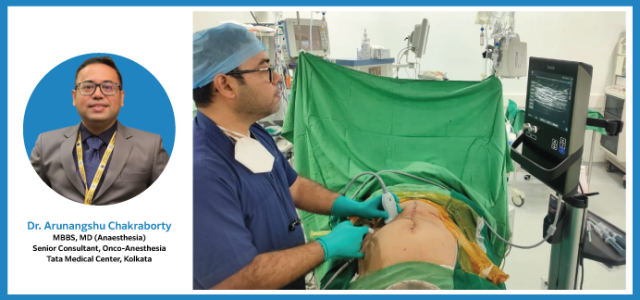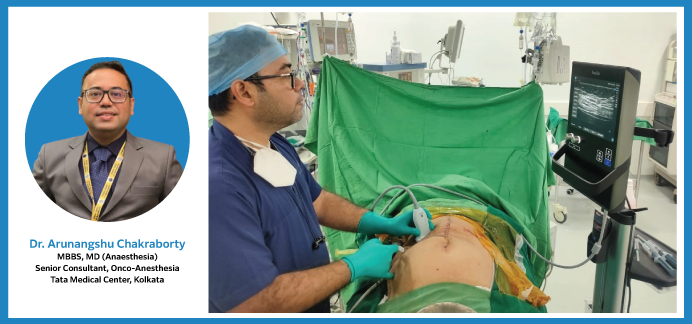
We recently interacted with Dr. Arunangshu Chakraborty, who is a senior consultant at the department of onco-anesthesia, TATA Medical Centre (400+ bedded cancer hospital & research center in Kolkata, West Bengal), to learn about his journey with point-of-care ultrasound.
Dr. Chakraborty is a medical graduate from NRS medical college, Kolkata and postgraduate in Anesthesiology from Motilal Nehru medical college, Allahabad, India. He pursued his clinical fellowship from NUH Singapore in year 2012 and has been practicing ultrasound guided regional anaesthesia and point-of-care ultrasound since then. He is a technophile and strongly advocates use of compact ultrasound - being noninvasive and radiologically safe imaging modality with excellent real time benefits for procedural guidance.
Dr. Chakraborty believes that the success rate of invasive procedures such as vascular cannulations, regional nerve blocks etc. has been significantly improved due to use of point-of-care ultrasound in his routine clinical practice. It has also fostered the development of new diagnostic and therapeutic procedures unknown hitherto, so that ultrasound guided interventions become a distinct discipline. Perioperative ultrasound is another exciting area where limited and targeted ultrasound examination has become a part of his clinical management algorithms.
Dr. Chakraborty has been using point-of-care ultrasound for the last 11 years and currently deploys Sonosite SII ultrasound system for guided regional nerve blocks and for other clinical applications to provide expert care to patients undergoing complex cancer surgeries:
- Lung ultrasound- It helps in the decision to extubate the patient on table or leave for overnight ventilation in long surgeries, especially emergency laparotomies. Presence of “B” lines in conjunction with a high peak inspiratory pressure requirement for ventilation points favorably towards ventilation.
- Echo screening: Patients posted for emergency surgery, who did not have a pre-operative echocardiogram is screened in the operation theater before induction of anaesthesia.
- Airway ultrasound- often required to mark the point of transtracheal injection of LA for awake FOB.
- Optic nerve sheath diameter: ONSD is an indirect marker of intracranial tension, and its measurement is often useful in prolonged laparoscopic surgeries in a Trendelenburg position, such as robotic prostatectomies, to aid the decision on extubating the patient after surgery.
- Gastric volume assessment: In emergency GI surgeries, stomach volume assessment is a useful tool to aid the decision of using a rapid sequence intubation or not.
Dr. Chakraborty is an esteemed Anesthesia faculty in national academic societies like AORA (Academy of Regional Anesthesia), GARC (Ganga Anesthesia Refresher Course) etc. and has a proven track record of organizing workshops including annual two-day USGRA workshop named TRACK (Tata Regional Anesthesia Course Kolkata) and many other POCUS courses across the country. He remains committed to make significant contributions to the field of Anesthesia through his clinical expertise and research work.


